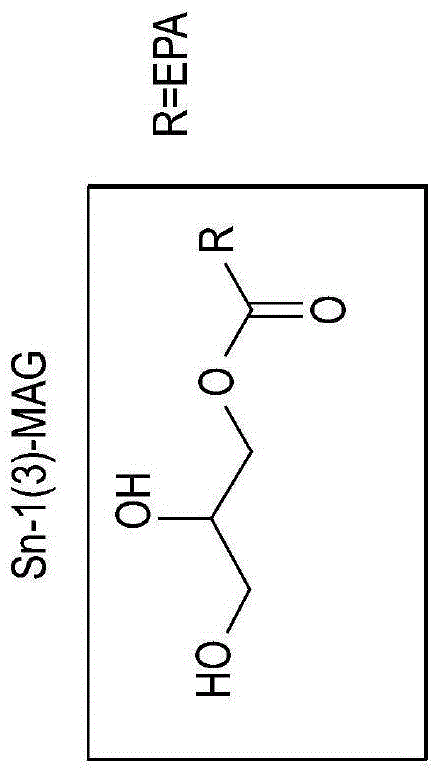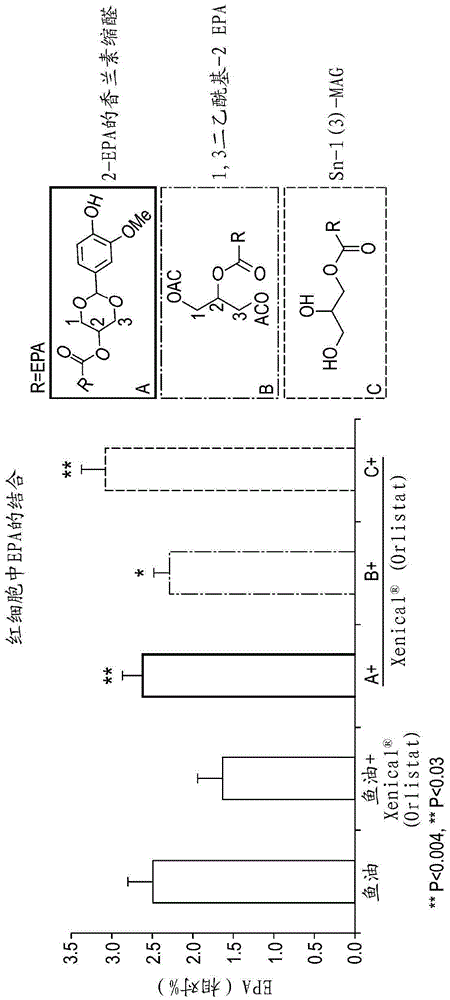Monoacylglycerols and fat-soluble nutrients for use in the treatment of maldigestion
A monoacylglycerol, nutrient technology, applied in the field of health and nutrition, can solve problems such as deficiency, and achieve the effect of enhancing absorption
- Summary
- Abstract
- Description
- Claims
- Application Information
AI Technical Summary
Problems solved by technology
Method used
Image
Examples
Embodiment 1
[0106] The concept was tested in a rat model of lipid maldigestion or malabsorption. use (ORLISTAT) to obtain dyspepsia or malabsorption conditions, is an inhibitor of pancreatic lipase and gastric lipase (lipostatin; see Figure 7 ). For 21 days, rats were fed with a long-chain polyunsaturated fatty acid (LC-PUFA) supplement consisting mainly of eicosapentaenoic acid (EPA). Fish oil was used as a source of triacylglycerols and different EPA glycerides were evaluated. Supplied at levels sufficient to reduce lipid absorption by 40% (ORLISTAT). will accept without (ORLISTAT) fish oil group was used as a positive control. Fatty acid profiles of erythrocyte lipids and plasma lipids were determined at different time intervals (D3, D7, D14 and D21). At the end of the experiment, the fatty acid profiles of the different tissues were determined.
[0107] The primary objective is to track EPA levels in red blood cell lipids and plasma lipids. The main comparisons evaluate...
Embodiment 2
[0111] This clinical study compared patients with Efficacy of sn-1(3) MAG and fish oil (TAG) to deliver EPA in humans with (ORLISTAT)-induced lipid dyspepsia disorder. Test and compare volunteers whose BMI is 37-40kg / m 2 And by (ORLISTAT) treatment to induce lipid dyspepsia or without (ORLISTAT) processing. The primary objective was to assess the accumulation of EPA in erythrocytes during a 21-day period of consumption as fish oil (TAG) or sn-1(3) MAG. Secondary objectives were to assess the accumulation of EPA in plasma over a 21-day period and to assess the pharmacokinetics of EPA after acute administration in the form of sn-1(3)MAG or TAG (AUC of chylomicrons at 10 hours postprandial ). see image 3 .
[0112] Table 1 Experimental group
[0113]
[0114] Pharmacokinetic results ( Figure 4 ) shows that, compared to fish oil and (ORLISTAT) treatment with sn-1(3)MAG and (ORLISTAT) treatment produced an acute effect that was statistically significant (p=0.0...
Embodiment 3
[0117] In vitro digestion to assess bioaccessibility of lipid fractions . Mock, or in vitro digestion, is a method used to assess the stability of lipid components such as fat-soluble vitamins and carotenoids and the partitioning of lipid components to form mixed bile salts during the stages of digestion (oral, gastric, and small intestinal stages). Modeling of the extent of the micellar fraction, a key step in the uptake of lipophilic substances. Partitioning of lipid components to form mixed bile salt micelles is also referred to as "bioaccessibility" and is expressed as the efficiency of micellization. Adjust the type of enzyme at each step as needed (eg, malabsorbed versus control) and as appropriate for the purpose (eg, TAG, MAG, vitamin, carotenoid).
[0118] In the procedure, fish oil was used as a source of triacylglycerol (TAG). Monoacylglycerol (MAG) was purchased from Cognis GmbH, Germany and mixed with sunflower oil at a ratio of 1:0.8 (w / w).
[0119] Triacylg...
PUM
 Login to View More
Login to View More Abstract
Description
Claims
Application Information
 Login to View More
Login to View More - R&D
- Intellectual Property
- Life Sciences
- Materials
- Tech Scout
- Unparalleled Data Quality
- Higher Quality Content
- 60% Fewer Hallucinations
Browse by: Latest US Patents, China's latest patents, Technical Efficacy Thesaurus, Application Domain, Technology Topic, Popular Technical Reports.
© 2025 PatSnap. All rights reserved.Legal|Privacy policy|Modern Slavery Act Transparency Statement|Sitemap|About US| Contact US: help@patsnap.com



